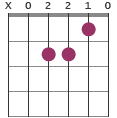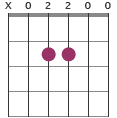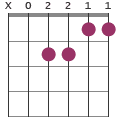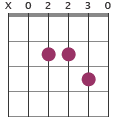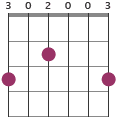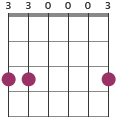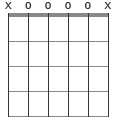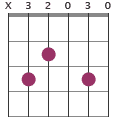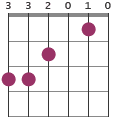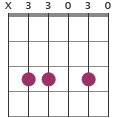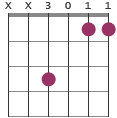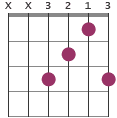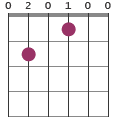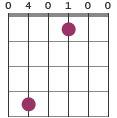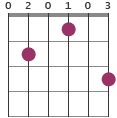Embellishment chords
A chord can be embellished for a more musical result. By combining chords with notes, melodies and other interesting elements, embellishments can be achieved. Two simple examples can demonstrate:


More examples can be found in the Illustrated Chord progression ebook.
Embellishment chords can have distinct names such as G/A and Em/D, but the chords presented here function as harmonic and melodic add-ons more than independent chords. In this guide you will see embellishment chords side to side with its “parent chord”, the regular chord, that is.
Embellishment chords create more flavor to the chord playing and adds interest to what is played. One easy way to create some variation is to add an in-between strum in chords changes with only open strings. In this case, it sounds best if open strings are arranged in a way that they match the other chords harmonically. For example, XX000X between a C and a D chord.
Another way is to create a rhythm by including strums with only open strings when a certain chord is played. For example, the A minor chord and X00000 on infrequently strums.
Another possibility with the Am chord is to hammer-on from X02200 to X02210. Hammer-ons are key element when it comes to chord embellishment, although this technique isn’t used in every case.
Am chord and embellishments
To the left is the normal chord version presented and when followed by possible embellishments.
Am
Embellishment
Embellishment
Embellishment
Comments
A tip is to learn the A minor scale, especially in open position (see GuitarScale.org for scale diagrams). You can use all notes in the A minor scale as embellishments for the Am chord. These can be executed with the hammer-on and pull-off techniques.
The correct names of the chords are not of huge interest here since they function as embellishments more than independent chords, but they are from left to right: Aadd2, AmaddF (Fmaj7/A) and Asus4.
The X02200 version can be used together with hammer-ons on the first fret, second string. And the X02230 version can be utilized with a bend on the third fret.
G chord and embellishments
To the left is the normal chord version presented and when followed by possible embellishments.
G
Embellishment
Embellishment
Embellishment
Comments
A tip is to learn the G major scale in open position (see GuitarScale.org for scale diagrams). All notes in the scale can be used as embellishments together with G major chord.
As said, the correct chord names are not very important, but they are from left to right: G6no5add2 (A7sus2/G), Gadd4 and G/A. G6no5add2 can also be played as 3X2003, which results in a G6(no5).
The 302003 version can be used as an in-between chord in a change from Am to G or as a variation from the ordinary G or even Am when strummed. The X0000X embellishment can be used as an in-between chord in a change from C to G or vice versa (something what happens automatically on occasions by the way). The note on second fret, fourth string is also common for hammer-ons and pull-offs together with the open D-string.
Finally, the 330003 version is probably most used in bass line contexts, when, for example, used together with 300003 and 320003.
C chord and embellishments
To the left is the normal chord version presented and when followed by possible embellishments.
C
Embellishment
Embellishment
Embellishment
Comments
Two of these chords are relatively common and are known as Cadd9 (X32030) and C/G (332010), but in this context, the chord names are not all that significant.
The third embellishment X33030 (can be called Cadd2add4) can be choice for alternating with Cadd.
Other ideas to combine with the standard C major chord are Csus2, Csus4 and Cadd2. Also, hammer-ons and pull-offs on second fret, fourth string from the open D-string are common approaches.
F chord and embellishments
To the left is the normal chord version presented and when followed by possible embellishments.
F
Embellishment
Embellishment
Comments
The two complementing chords are in this case known as Fsus2 and Fadd9. These can be used together with F major to create nice sounds. When changing to F in a progression, you could choose Fsus2 and when hammer-on into F.
E7 chord and embellishments
To the left is the normal chord version presented and when followed by possible embellishments.
E
Embellishment
Embellishment
Embellishment
Comments
The first of these embellishments is relatively common and is known as E6 (022120). The second embellishments can be named E7add6. The third alternative (020103) can be named E7addG.
These are mostly useful in blues.
A common approach in blues context is to hammer-on the note on the first fret, third string from the open E7.
Another idea is to alternate between E major (022100), E7 (022130) and E6 (022120), which only involve changing the little finger on the 2nd string.
Back to resources
